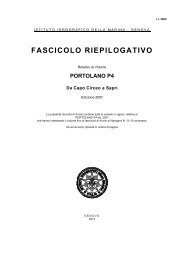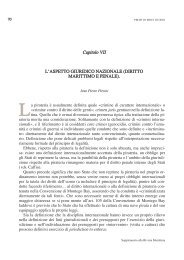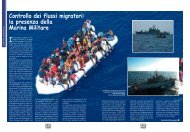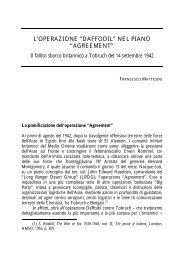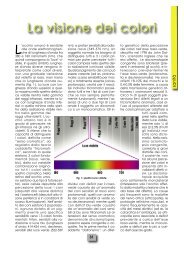143 Anno XVIII - 2008 - Marina Militare
143 Anno XVIII - 2008 - Marina Militare
143 Anno XVIII - 2008 - Marina Militare
You also want an ePaper? Increase the reach of your titles
YUMPU automatically turns print PDFs into web optimized ePapers that Google loves.
framework in mind that in those years research<br />
studies were conducted for the design of a<br />
16,000-ton light helicopter carrier capable of<br />
8 to 14 HSS-2 helicopters. 39 It is also in this<br />
period, that options were examined for a 7,000-<br />
8,000-ton landing ship based on the model of<br />
the Italian San Marco class. 40<br />
natIonal strategy beyond<br />
the cold war: achIevIng<br />
exPedItIonary flexIbIlIty<br />
The sudden end of the bipolar confrontation and<br />
the implosion of the Soviet Union left Japanese<br />
political circles – as much as those in other nations<br />
of the Western bloc – rather disoriented on the<br />
courses of action to guarantee security. 41 The<br />
failure to provide some form of military support<br />
in the first Gulf War prompted many to question<br />
the merits of Japan’s mercantilist foreign policy.<br />
Tokyo – they argued – had to address some of its<br />
constitutional constraints in order to be able to<br />
participate with a degree of military commitment<br />
in operations under international mandate,<br />
‘normalising’ its behaviour as a state actor.<br />
In February 1994, Prime Minister Hosokawa<br />
Morihiro (1993-1994) took the initiative and<br />
commissioned a report with the intent of<br />
reassessing the country’s defence capability.<br />
Once released, the recommendations of the socalled<br />
Higuchi committee constituted the basis<br />
for the drafting of the new NDPO, 42 which was<br />
eventually adopted in November 1995. 43 Both<br />
documents recognised in cooperative patterns<br />
of security the likely leitmotifs of future<br />
international relations and suggested a defence<br />
agenda aiming at engaging in a more ‘active<br />
and constructive security policy’. 44 Attention<br />
to international stability was certainly the main<br />
intellectual novelty of the document but it was<br />
not the only priority Japanese strategic planners<br />
sought to address. In Northeast Asia, the power<br />
vacuum created by the disappearance of one<br />
of the superpowers had made the situation<br />
more volatile, with unresolved and potentially<br />
escalating tensions in the Korean Peninsula and<br />
across the Taiwanese strait. Equally testing for<br />
regional stability were the actions of state actors<br />
such as China seemingly profiting from the post-<br />
Cold War transition to achieve greater influence,<br />
engaging to that end in a comprehensive scheme<br />
of economic and military modernisation. 45<br />
The NDPO was drafted seeking to balance<br />
the requirements for a higher international<br />
military profile and those necessary to deal with<br />
closer regional sources of military (and naval)<br />
apprehension. 46 The Japanese armed forces had<br />
to become as a result, ‘streamlined, effective<br />
and flexible’. 47 For the JMSDF the new pos-<br />
ture demanded the enhancement of the service<br />
ability to offer agile and accurate responses,<br />
rebalancing the various components of the<br />
fleet to perform not only ASW duties but to use<br />
seapower to support the nation’s renewed commitment<br />
to the international community. 48 On<br />
the other hand, the document reaffirmed the basic<br />
requirements of the national naval strategy<br />
drawing a line of continuity with the previous<br />
NDPO in that ‘the defence of adjacent seas and<br />
the securing the safety of maritime traffic are<br />
essential in order to secure the foundations of<br />
national survival’; this constituted a ‘matter of<br />
life or death’ whether in peacetime or in cases<br />
of emergency. 49<br />
The inherent flexibility of naval platforms in<br />
pursuing both the international and national<br />
objectives of Japan’s transforming defence<br />
ensured the role of the JMSDF in national defence,<br />
and though it did not prevent a downsizing of<br />
the fleet’s inventory, it did pave the way for<br />
platforms with a strong expeditionary appeal.<br />
In the Pacific, the naval core of Japan’s most<br />
apparent Cold War threat had started depleting<br />
rapidly and whilst China’s expanding ‘scope of<br />
activities in the high seas’ was to be observed<br />
with a keen eye, its force modernisation was<br />
‘expected to gradually proceed at a moderate<br />
rate’. 50 Such considerations were coupled with<br />
other more crucial domestic factors, namely a<br />
period of severe economic recession which had<br />
affected the country since the beginning of the<br />
decade. Compared to the force level established<br />
by the 1976 NDPO, the new document called<br />
for a reduction of approximately 16% of the<br />
surface fleet (from approx. 60 to approx. 50<br />
major vessels) and of almost 23% of the air<br />
component (from approx. 220 to approx.<br />
170 aircraft). 51 The principal addition to the<br />
navy’s evolving inventory was introduced in<br />
1993, when following the first deployments<br />
overseas for UN-led peace support operations,<br />
the JMSDF dusted off the mid-1980s studies<br />
for a larger amphibious unit and used them as<br />
basic design to procure its first landing ship,<br />
Osumi (LST-4001). With its 8,900 tons of<br />
displacement, helicopter flight deck, internal<br />
landing platform dock (LDP) equipped with<br />
landing crafts air cushion (LCAC), the Osumi<br />
soon became an iconic symbol of the JMSDF’s<br />
contribution to Japan’s ambitions as an active<br />
player in international stability. The limited<br />
presence of point-defence systems for selfprotection<br />
emphasised its original vocation as a<br />
delivery platform, but made it also dependant<br />
on the protection of other escort units in the<br />
case of overseas dispatches. In 1998 and 1999,<br />
other two units of the same class were procured<br />
to fulfil the requirements of the new national<br />
official policy.<br />
<br />
3



